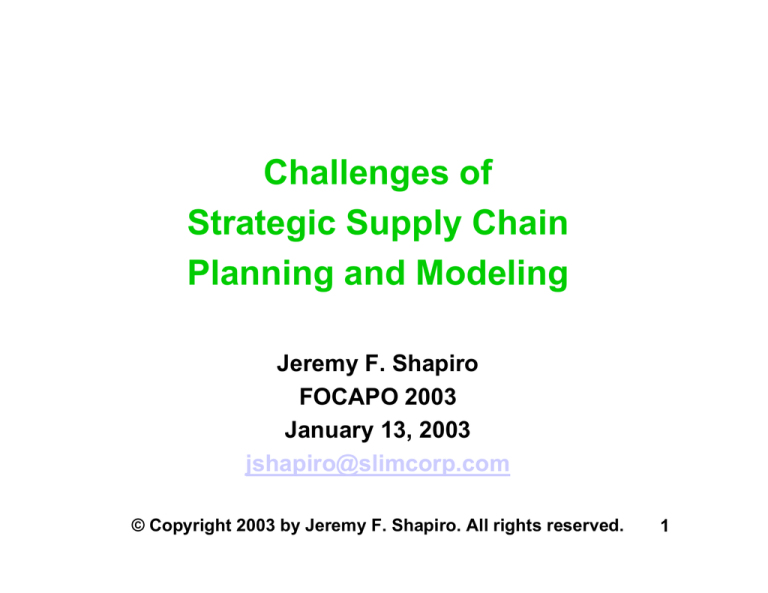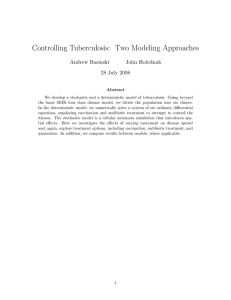Challenges of Strategic Supply Chain Planning and Modeling Jeremy F. Shapiro
advertisement

Challenges of Strategic Supply Chain Planning and Modeling Jeremy F. Shapiro FOCAPO 2003 January 13, 2003 jshapiro@slimcorp.com © Copyright 2003 by Jeremy F. Shapiro. All rights reserved. 1 Agenda 1. Introduction 2. Enlarging the Scope of Strategic Supply Chain Planning Studies and Models 3. Reflecting Theories of Strategy in Data Driven Models 4. Formalizing Scenario Planning, Applying Stochastic Programming and Modeling Risk 5. Expanding Business Processes to Exploit Fact-Based Analysis of Strategic Plans 6. Conclusions 2 1. Introduction • Supply chain managers in a wide range of industries and companies are actively seeking tools to support fact-based decisionmaking fact-based = data-driven • Emerging applications at all levels of planning (strategic, tactical, operational) • Strategic planning concerned with – – – – analyzing major acquisition and divestment decisions understanding and exploiting core competencies anticipating and responding to plans of competitors hedging against uncertainty and risk 3 Strategic Analysis Managerial Intuition Prescriptive Model ERP Database Descriptive Models Decision Database 4 Windows 9. User Interface 2. Scenario Data 3. Supply Chain Tables Decision Database 10. Middleware - aggregations - forecasting - ABC 4. Model In MPS Format 1. Model Generator 5. Optimizer 8. Reports 7. Report Generator 6. MPS Solution Analytical Engine Enterprise Resource Planning Database Internet Accessed Databases Optimization Modeling System Schematic 5 2. Enlarging the Scope of Strategic Supply Chain Planning Studies and Models Challenges • Can purchasing, manufacturing and distribution planning activities be integrated? • Can multi-period analysis be performed to assess the timing and phasing of major decisions? • Can supply chain and demand management decisions be integrated net revenues = gross revenues – cost • Can corporate financial decisions be integrated with strategic supply chain decisions? 6 3. Reflecting Theories of Strategy in Data-driven Optimization Models • Some theories are qualitative while others are quantitative but not data-driven – – – Five forces affecting competition (Porter 1980) Theory of industrial organization (Tirole 1988) Resource-based view of the firm (Foss 1997) • Benefits – Theories provide important concepts and vocabulary Challenges • • • How can concepts be translated into descriptive and prescriptive models? To what extent can model results be interpreted in terms of theories? Can theories be extended to overcome flaws revealed by datadriven models? 7 Entry Barriers Five Forces Economies of Scale Brand Identity Switching Costs Capital Requirements ….. New Entrants Industry Growth Fixed Costs Value Added Intermittent Overcapacity ….. Industry Competitors Suppliers Buyers Determinants of Supplier Power Differentiation of Inputs Switching Costs Presence of Substitutes Supplier Concentration Importance of Volume Cost Relative to Total Cost Threat of Backward Integration ….. Rivalry Determinants Intensity of Rivalry Substitutes Determinants of Substitution Threat Relative Prices ….. Determinants of Buyer Power Buyer Concentration Buyer Volume Switching Costs Ability to Backward Integrate Price Sensitivity Product Differences Brand Identity ….. 8 Theory of Industrial Organization • Concerned with the theory of the firm, how firms compete for profits, and how markets respond to prices • Scholars use abstract (data less) mathematical models and analysis to gain insights into strategic, competitive behavior • Theory has considerable overlap with optimization models for supply chain and demand management • Competitive equilibria may be computed using mathematical programming methods • Conflicts arise between mathematical assumptions about the behavior of the firm and its markets and real-world phenomena such as fixed costs, economies of scale, market imperfections, other externalities 9 Taxonomy of a Firm’s Resources • Physical resources (plants, DC’s, inventories) • Human resources (machine operators, production managers, scientists) • Financial resources (cash flow, debit capacity, equity availability) • Information technology resources (inventory management system, intranet, supply chain modeling system) • Marketing resources (market share, brand recognition, goodwill) • Organizational resources (training systems, corporate culture, supplier relationships) • Legal resources (patents, copyrights, contracts) 10 Resource-based View of the Firm • RBV states that a superior firm possesses heterogeneous resources that differentiate it from other firms and allow it to earn rents (large profits) heterogeneous resources = core competencies • A heterogeneous resource cannot easily be imitated, substituted for, or transferred • Sustainability of competitive advantage requires the firm to – have sufficient time to learn how to create and exploit heterogeneous resources – understand the interconnectedness of assets, which may be obscured by causal ambiguity 11 Resource-based View of the Firm (cont) • A firm’s resources may be tangible (can be modeled) or intangible (cannot be modeled) • Tangible resources fall into three categories: heterogeneous, homogeneous, stranded • Challenge – how can optimization models be used to analyze tangible resources from the RBV perspective? 12 4. Formalizing Scenario Planning, Applying Stochastic Programming and Modeling Risk 13 Formalizing Scenario Planning • Analysis of multiple scenarios of the firm’s future is at the core of any strategic supply chain planning exercise Challenge – how to define scenarios that are consistent, plausible and comprehensive? • Schoemaker (1993) proposes ten-step method for defining scenarios – scenarios are focused descriptions of fundamentally different futures presented in coherent narratives – centers on learning and exploring interrelationships among strategic trends and key uncertainties – overcomes overconfidence and tunnel vision 14 Optimization Modeling of Uncertainty and Risk Challenge – when and how may deterministic optimization of multiple scenarios be replaced by stochastic programming? Deterministic optimization – multiple scenarios and associated data are optimized one at a time as if each will occur with certainty Stochastic programming – considers the entire ensemble of scenarios, each with a probability of occurrence, in identifying an optimal contingency plan for each scenario and a here-and-now plan that optimally hedges against all of them 15 Modeling Risk Using Stochastic Programming • Impose constraints reflecting decision-maker’s judgment of risks faced by the firm and/or the decision-maker – – – losses by the firm in any year cannot exceed $50 Million inventories of finished goods at the end of any quarter may not exceed 1 Million units market share of key product line at the end of any year may not fall below 33% • Probabilistic risk constraints – the probability that losses in any year exceed $50 Million cannot exceed 0.02 16 Stochastic Programming Applications • Manufacture of computer chips, chemicals for pharmaceutical products when faced with uncertainty in finished products • Products with short life cycles • Postponement strategies • Management of energy supply and demand contracts • R&D 17 Using Stochastic Programming to Analyze Real Options • Real options involve tangible resources that can be managed in ways that eliminate the need for financial options to hedge risks associated with prices, foreign exchange rates, demands, and other sources of uncertainty – multinational corporations – electricity generation – project financing • Dynamic investment strategies that include options such as: to wait/to defer, to abandon/exit, to expand, to contract, to switch, or to improve 18 Technical Challenges of Stochastic Programming Challenge 1 – Estimate probabilities of occurrence of each scenario – combine statistical and judgmental information – discretize continuous distributions into a finite number of scenarios without introducing arbitrage opportunities Challenge 2 – Use methods of multiple objective optimization to explore tradeoffs of return versus risk Challenge 3 – Control model size – many sources of uncertainty – many stages – develop and apply approximation methods using Monte Carlo simulation, aggregation, decomposition combined with heuristics 19 5. Expanding Business Processes to Exploit Fact-based Analysis of Strategic Plans Challenge – to what extent do the firm and its managers wish to base (supply chain) strategic planning on facts and rational decision-making? Rational Camp – believes that the firm and its managers will be rational in their decision-making, at least within limits set by their information gathering resources Behavioral Camp – observes that, although the firm and its managers may attempt to make intelligent decisions leading to desirable outcomes, many managers are inconsistent because they cannot overcome problems due to ignorance, conflict and ambiguity 20 Business Process Expansion • Develop and maintain modeling systems and decision databases integrated with ERP systems • Create new processes for repetitive review of the firm’s strategic plans including scenario planning and conflict resolution • Create new support staff who maintain decision databases and perform repetitive analysis of strategic plans • Devise new managerial incentives schemes that reflect holistic supply chain (strategic) management 21 6. Conclusions • Strategic supply chain planning can and should address decisions across the entire supply chain including suppliers, manufacturing and distribution facilities, transportation activities, and customers • Strategic supply chain planning and modeling can and should be extended to include demand and corporate financial planning and modeling • Formal scenario planning and analysis with stochastic programming models have the potential to significantly improve strategic planning 22 Single Period Deterministic Multiple Period Deterministic Min Cost over SC Decisions Max Revenue over SC & Mktg Decisions Competitive Equilibria Model Type 1 Model Type 2 Model Type 3 Model Type 4 Model Type 5 Corporate Finance Model Type 8 Multiple Period Stochastic Model Type 6 Model Type 7 23 • Business process expansion is needed to overcome human and organizational barriers to (limited) rational decision making based on the results of descriptive and prescriptive models 24





